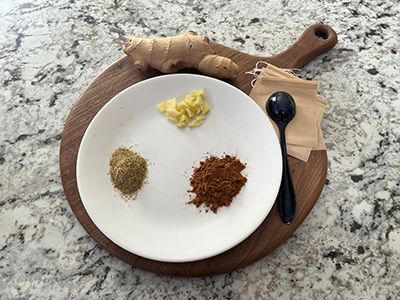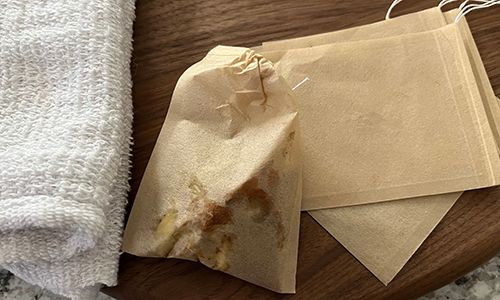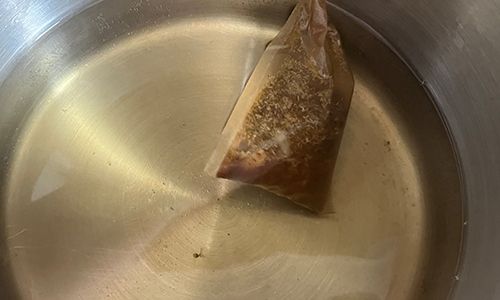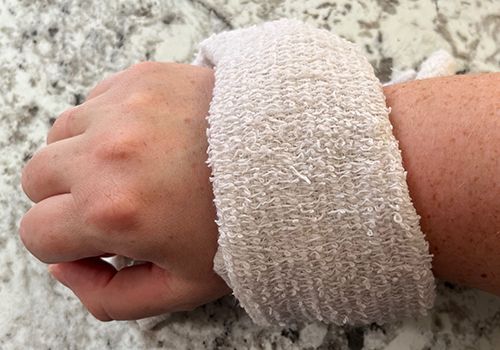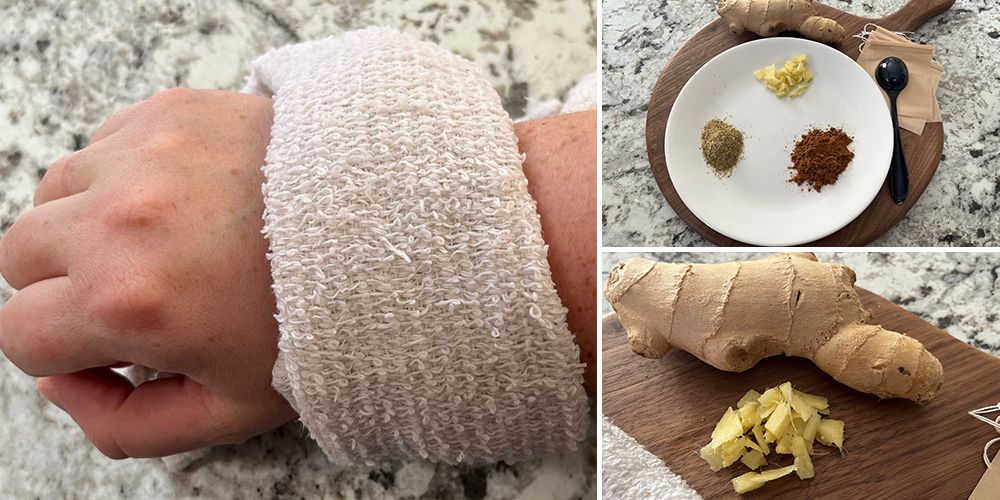
Anti-Inflammatory Diet: Use This to Unlock Your Joints
Experiencing locked joints and joint pain can cause immense discomfort and frustration in all aspects of your daily life. While you may be working to mediate the underlying causes with physical therapy and lifestyle changes, when flare-ups emerge, you might be seeking immediate relief. Fortunately, there are many herbs in your kitchen that will help unlock your joints, particularly when combined in an infusion and used as a warm or cold compress.
What is joint locking?
Locked joints happen when a joint cannot fully extend. Joint locking is a common struggle for people who experience conditions like osteoarthritis, where inflammation causes the flexibility of the joints to break down. This problem can often worsen with movement, and weight-bearing joints can either lock up or “give out” at the end of the day after prolonged use.
Another cause of joint locking may be gout, another form of arthritis that can also cause pain and inflammation in the joints, reducing mobility. Gout occurs due to a urate buildup in the blood that forms needle-like crystals in the joints. Certain factors, including diet, alcohol use, and family history, can increase one’s risk of developing gout. The result is painful flare-ups of joint inflammation, swelling, and redness.
Pseudo-locking
Pseudo-locking is a much more common condition caused by muscle spasms, making it more challenging and uncomfortable to extend the joint fully. This can happen after an injury or a tear in the tendon. While it can be very painful to fully extend the joint, it isn’t locked or completely incapable of extension, as would be the case in the previous two instances of joint-locking.
How to Finally Get Relief from Joint Lock
If you experience locked joints, the lack of mobility can be stressful. Alongside treating the underlying cause of the joint locking, herbal remedies can also help relieve painful symptoms. They can also help decrease the inflammation that can exacerbate the locking, spasms, or flare-ups.
Each condition resulting in joint pain requires lifestyle changes with a focus on reducing inflammation, gentle movement and stretching, and other medical care. Inflammation can worsen with diet, inactivity, use of tobacco or alcohol, poor sleep, exposure to toxins, and even an imbalance of gut microbes. Studies have shown that certain herbs are particularly helpful in reducing inflammation that causes locked joints. Many of these herbs can be consumed as part of an anti-inflammatory diet, or you can create an infusion compress to provide relief directly to the source.
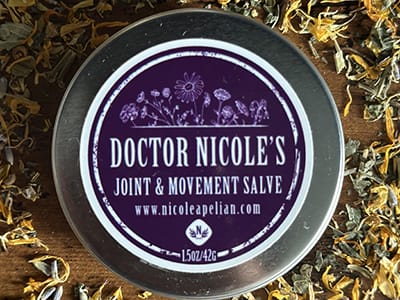
What I dislike most is all the work I need to put into making my own remedies that I’m sure are 100% natural. But if I really had to choose joint support products, I’d make sure they are non-GMO and from a trusted source. For me, it’s this salve from Nicole’s Apothecary. She’s a living example of nature’s way of dealing with things being superior.
What is a compress?
A compress applies either warm or cool temperatures directly to an area of the body to relieve pain or discomfort. Using a cold or warm compress can be as simple as wrapping the joint in a warm or cold towel, but you can also benefit from using a towel soaked in a herbal infusion to provide additional relief.
Warm Versus Cold Compress
Whether you want to use a warm or cold compress on your locked joints depends on the time of day and the type of pain or discomfort you wish to relieve. Heat is much more effective at soothing tense muscles and joints and helping to promote relaxation. This is especially helpful if your joints have locked up after a long day of use. Warm compresses can also relax the nervous system and promote better sleep.
On the other hand, cool compresses are also effective at reducing inflammation and swelling. It can help numb intense, sharp pain and reduce heat or redness in the joint. In this instance, you may want to use a cold compress in the morning if you wake up feeling particularly stiff.
Inflammation-Fighting Ingredients
There are several powerful herbs and natural ingredients that can help reduce pain, inflammation, and muscle spasms related to locked joints, osteoarthritis, and even gout.
Ginger
Ginger, among its many other benefits, is a potent antioxidant and anti-inflammatory. Studies in patients with osteoarthritis found ginger had a similar effect as common NSAIDs in relieving joint pain. It does this by inhibiting COX-2 enzymes that cause inflammation and pain, similar to over-the-counter medications. Ginger can also be applied topically to the affected areas during gout flare-ups to provide some relief.
Cinnamon
Cinnamon is another powerhouse herb that can help unlock your joints, especially in combination with ginger. It contains cinnamaldehyde and cinnamic acid, both powerful antioxidants that prevent cell damage caused by free radicals. Cinnamon and ginger together also have an antispasmodic effect on the muscles, which is helpful for the pseudo-locking of joints.
Chamomile
Chamomile is a powerful herb with a medicinal history that dates back thousands of years. In addition to reducing inflammation, chamomile helps to subdue muscle spasms, promote wound healing, and encourage restful sleep. Those suffering from joint locking or pain can benefit from chamomile, as the pain of locked joints can cause immense stress and frustration due to the impact of these conditions on their daily lives. Adding chamomile to your infusion compliments ginger, giving a more soothing effect.
Ever since I started growing my own chamomile inside my own home I finally felt the true taste that doesn’t contain any pesticides! If you have a pot and a window, you’ve already got an unlimited source of ‘the natural antibiotic’. Here’s how to make it.
Tinctures
If you also suffer from mobility and pain issues, there’s a complete kit that actually targets multiple root causes. I use all four tinctures to help alleviate discomfort, inflammation and my overactive immune system. Besides, the joint salve included was a miracle-worker for me.
The reviews of this bundle made me and my family try it a year ago, and it truly delivers!
How to Make Your Herbal Joint Compression
While compressing herbs directly to the skin can cause irritation, using a warm or cold compress with a herbal infusion of beneficial ingredients can provide you with relief when your joints are locked. As with any topical treatment, you should test a small amount on your skin to prevent irritation or allergies.
Ingredients
- 4-6 cups of water in a medium to large pot
- An empty tea bag (or you can make your own with some cheesecloth)
- A washcloth, small towel, or some gauze for your compress
- 2 teaspoons of fresh ginger, grated or chopped (or 1 teaspoon of dried ginger if that is all you have available)
- 1 teaspoon of ground cinnamon
- 1 teaspoon of dried chamomile (or 2 teaspoons of roughly chopped fresh chamomile). If you struggle to find chamomile, consider swapping this with 1 teaspoon of organic chamomile tea.
Make your infusion
- First, bring your water to a boil. Then remove from heat.
- Secure your herbs in your tea bag or cheesecloth. This prevents the raw ginger from floating around in your infusion. Raw ginger applied directly to the skin may cause a burning sensation.

- Allow your herbs to steep in the water for approximately 10-15 minutes.

- Next, allow your infusion to cool to a temperature that you find comfortable. For a cold compress, let your infusion fully cool off, then place it in the refrigerator overnight.
Applying your compress
- Soak your cloth or towel into the infusion for a few minutes, then wring out the excess.
- Test the temperature of the cloth on the affected area before applying the compress; for a warm compress, it should feel warm but not hot.
- Apply your compress for approximately 15 minutes or until discomfort starts to subside. For a warm compress, you may wish to lay a dry towel over the top of the area to lock in the heat.

Storage
If you’d like to reuse your infusion once it has cooled, you can place the mixture in the refrigerator and use it within 48 hours. You can also reheat your infusion on the stovetop or continue to use it as a cold compress if desired.
If you enjoy the flavor combination of ginger, cinnamon, and chamomile, you can also drink this infusion as a tea, though you may want to set some of the infusion aside before dipping a cloth into it!
Optional Ingredients You Can Add to Your Infusion
If you want to experiment with additional ingredients that help with inflammation and joint repair, there are more herbs that you can try:
Valerian: Valerian is great for promoting healthy sleep, which helps with muscle and joint repair. Adding this to your infusion can increase relaxation and rejuvenate your tense muscles and inflamed joints.
Dried (or fresh) pineapple: Pineapple is highly anti-inflammatory and is often recommended to reduce inflammation during gout flare-ups.
Turmeric: Turmeric is another ingredient that is very effective at reducing inflammation. Studies have found that it can even have similar effects as NSAIDs for relieving joint pain and discomfort in people suffering from osteoarthritis. The active ingredient in the turmeric root is curcumin, which blocks inflammatory enzymes. If you add turmeric to your infusion, remember it can dye the skin.
Cayenne: Cayenne has a long history of use in herbal medicine due to the active ingredient, Capsaicin. It is commonly recommended to help reduce pain and inflammation for those suffering from osteoarthritis, muscle spasms, and joint pain. Cayenne is very potent, so use it very sparingly!
You may also like:

